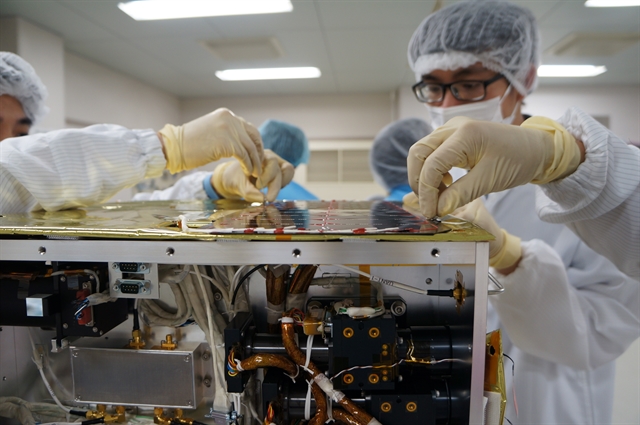 Society
Society


|
| Research at the Việt Nam National Space Centre under the Việt Nam Academy of Science and Technology. — VNA/VNS Photo |
HÀ NỘI — Việt Nam can no longer rely on increasingly scarce natural resources to drive its growth and must seek to improve its “internal strengths” by pursuing science, technology and innovation, according to Prime Minister Nguyễn Xuân Phúc.
“This outdated foundation for growth will soon exhaust, and once it does, the economy will slow down and eventually fall into a decline,” the Government leader wrote in article released yesterday on the Government’s resolve for science, technology and innovation development ahead of Việt Nam’s Science and Technology Day, May 18.
To counter this threat, a strong technology basis and a high-quality workforce are the “decisive factor” to ensure long-term growth and crucial for Việt Nam to avoid the middle-income trap, PM Phúc said.
The improvements in labour quality are demonstrated by the fact that productivity has seen a gradual increase from 33.6 per cent in 2011-15 to 43.3 per cent in the next three years, and an estimated average of 43.5 per cent in 2016-20, which will ensure Viet Nam surpasses its target of 35 per cent in 2011-20.
“These figures illustrate our progress in economic restructuring and moving up on the value chain,” PM Phúc said and attributed these positive signs to efforts in developing science and technology.
Việt Nam’s Global Innovation Index has improved in recent years and frequently topped low middle-income countries.
“However, we must take a frank look at the challenges and difficulties facing us to see that science, technology and innovation development in Việt Nam remains fraught with issues,” the Government leader said.
First and foremost, local authorities’ awareness of the need to put science and technology at the forefront is insufficient while the national legal framework and policies “are not creating sufficient motivation for the application and development of science and technology,” he wrote.
Science and technology has not been strong enough to form a solid basis for socio-economic development, the country’s growth or economic restructuring, he said.
There’s a significant gap between Việt Nam and the top players in Southeast Asia, PM Phúc lamented, while the fledging national innovation system lacks cohesion.
There’s not enough research and development (R&D) going on at enterprises in the private sector, while universities focus on education instead of research, PM Phúc said.
“In the last few years, Việt Nam’s investment in science and technology has been rising but the ratio of this amount over the GDP is not commensurate with the country’s economic growth speed,” he wrote, adding that the World Economic Forum said Việt Nam is lagging behind in terms of labour productivity, innovation and technology preparedness compared to many of its neighbours in Asia like China, India, Thailand and Singapore.
Both the public and the private sector must realise the importance of investing in science and technology, while making sure this investment is effective and pays long-term dividends.
“We must find a practical way to galvanise businesses to step up investment into R&D, and not just by paying lip-service,” PM Phúc said.
Five-pronged approach
The PM added that Việt Nam is committed to pursuing a socialist-driven market economy as a “strategic mission and a breakthrough measure” to build a prosperous society, join the ranks of the high-middle income countries in 2030, and advance into a developed nation by 2045, the centennial of the birth of the modern Việt Nam.
The Government leader said this would only be possible when science and technology is at the heart of the country’s development strategy.
“There must be better co-ordination between the State and society in developing science and technology. We must have total factor productivity accounting for 50 per cent of the country’s growth, with labour productivity improving by at least 6.5-7.0 per cent a year on average,” wrote PM Phúc.
In the article, PM Phúc said State agencies, especially the Ministry of Science and Technology, should focus on five priority areas – policies to promote innovation in businesses; crafting appropriate mechanisms to facilitate the development of high-quality human resources; improving connections between innovation networks inside and outside the country; enhancing State administration capabilities and perfecting legal frameworks for innovation and technology; and revising all existing science and technology programmes and missions to ensure they bring higher value added in products.
The Government leader also pointed out specific tasks that should receive higher attention, including the development of a measurement framework to assess the efficiency of the digital economy and performance of science and technology institutes, a national database on science, technology and innovation, “out of the box” and “open, creative” policies to attract talents – domestic or foreign, especially overseas Vietnamese and application of public-private partnerships to push for further involvement of businesses in science, technology and innovation. — VNS




